Want an impressive physique? Yeah, us too. Bodybuilders really caught on to something when they started showing up on stage with pronounced V-tapers. You don’t need to be a competitive physique athlete to get a V-taper, though.
You just need the right workout program, and understanding the factors that create the V-taper will help, too. This article will provide you with both, along with some expert commentary from a competitive bodybuilder.
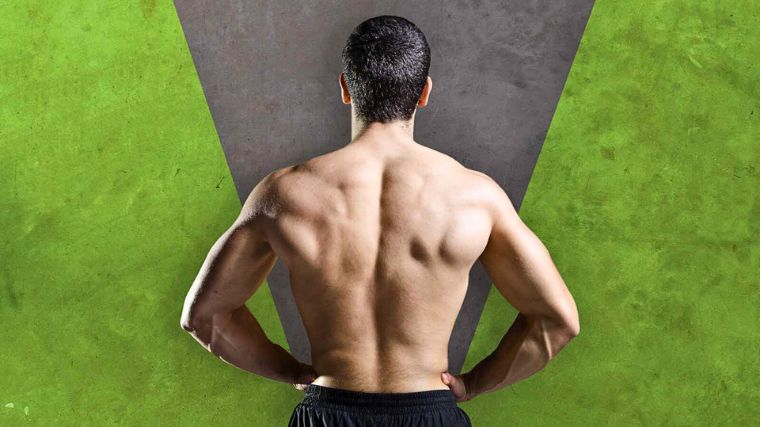
[Related: The Best Back Exercises and Workouts]
What Is a V-Taper?
The V-taper isn’t caused by any one muscle, nor does it describe a muscle or body part. The V-taper refers to your shoulder-to-waist ratio, particularly when viewed from the back. People with pronounced torso tapers appear to have wide shoulders and narrow waists.
Three factors contribute to the v-taper aesthetic. If you want to get a v-taper of your own, you’ll need to hit at least two of these three benchmarks:
- Back hypertrophy, particularly in the lats
- Low levels of body fat
- Long clavicle bones and a narrow pelvis
Two of these factors are within your control, but you can’t change the proportions of your skeleton. If you’re blessed with broad shoulders due to having long clavicles, your torso will have a natural taper by default. If you have wide hips and narrow shoulders, it’s still possible to build a tapered torso; it may just take a bit more time.
[Read More: The 12 Best Upper Back Exercises for Muscle and Strength]
The V-taper may be an aesthetic choice for bodybuilding, but it also has merit outside of physique sports. Studies have shown that the shoulder-to-waist ratio (or hip-to-waist ratio for women) influences romantic success, conveys confidence and authority, and helps you be perceived as generally fit. (1)(2)
Bodybuilding V-Taper vs. X-Frame
A tapered torso is important for physique athletes across many different divisions. You can attribute the look, at least in part, to golden-era bodybuilders like Arnold Schwarzenegger or Frank Zane. In the modern era, bodybuilders in the Men’s Physique and Classic Physique divisions also value the v-taper.
The X-frame is similar to the v-taper, but factors in how muscular an athlete’s lower body is. The X-frame describes a physique with broad shoulders, a narrow or tight waist, and muscular legs — specifically, the quadriceps.
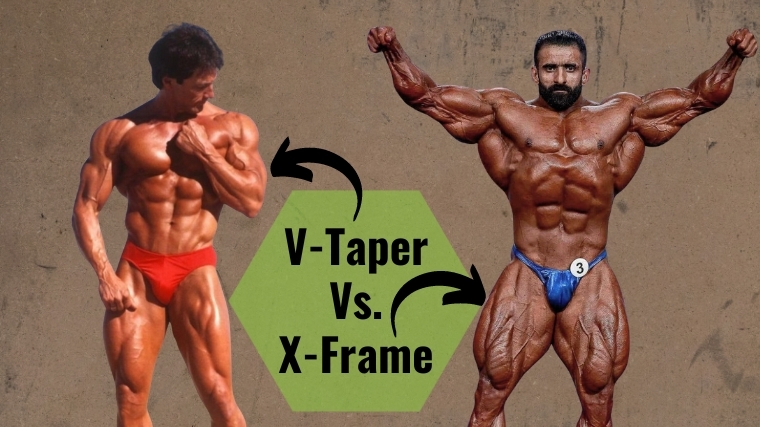
[Related: 10 Bodybuilding Poses — What They Are and How to Do Them]
Anyone who achieves the X-frame look will also have a v-taper, but the inverse isn’t necessarily true. The X-frame aesthetic is more popular in Men’s Open bodybuilding, but is also coveted among women athletes in the Wellness, Figure, and Physique divisions of women’s bodybuilding.
V-Taper Muscles
Here’s a breakdown of the major muscles that contribute to the appearance of a V-taper, in order of importance:
- Latissimus Dorsi: Your lats, which run down the length of your back, create the illusion of broader shoulders and a smaller waist.
- Lateral Deltoid: Growing your lateral deltoids (aka side delts) will create the appearance of wider shoulders relative to your waist.
- Triceps: When viewed from the back, pronounced triceps will slightly widen your silhouette and make your waist appear smaller.
- Obliques: Overdeveloped obliques can sometimes widen your waist and may negatively impact your V-taper. If you’re prioritizing a tapered aesthetic, you may want to limit how many oblique exercises you regularly perform.
How To Get a V-Taper
V-taper workouts are all about emphasizing the two or three muscle groups that create the look. That’s your lats, lateral delts, and to a lesser degree, triceps. Prioritizing hypertrophy (or muscle growth) in these muscles with back and shoulder workouts is key.
Good V-taper exercises emphasize back width more than thickness. This likely means adjusting your row grip, limiting how much work your upper back does, and hammering away at shoulder exercises like lateral raises. Here are three examples of bodybuilding V-taper workouts:
V-Taper Workout 1
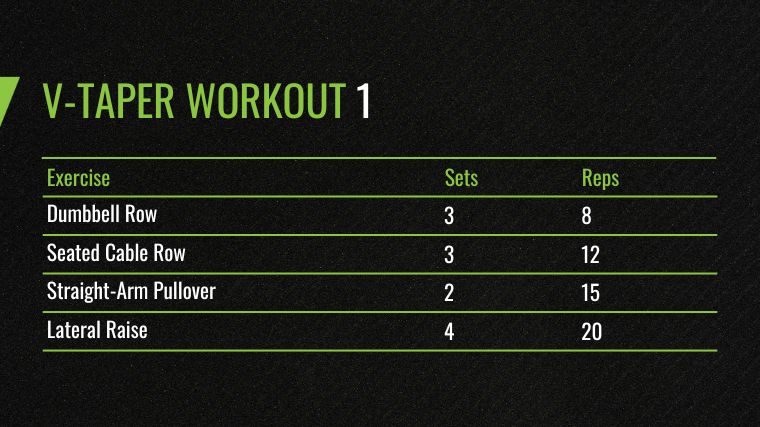
- Dumbbell Row: 3 x 8
- Seated Cable Row: 3 x 12
- Straight-Arm Pulldown: 2 x 15
- Lateral Raise: 4 x 20
V-Taper Workout 2
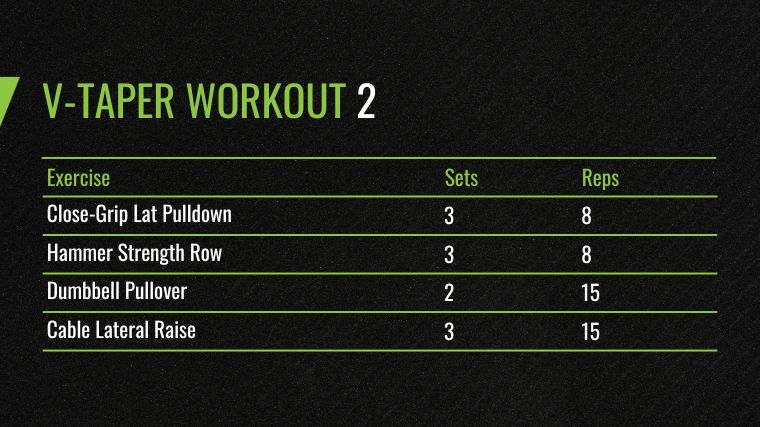
- Close-Grip Lat Pulldown: 3 x 8
- Hammer Strength Row: 3 x 8
- Dumbbell Pullover: 2 x 15
- Cable Lateral Raise: 3 x 15
V-Taper Workout 3
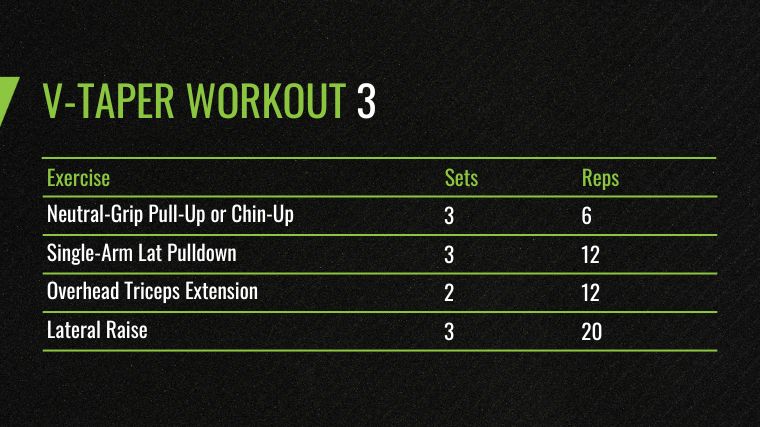
- Neutral-Grip Pull-Up or Chin-Up: 3 x 6
- Single-Arm Lat Pulldown: 3 x 12
- Overhead Triceps Extension: 2 x 12
- Lateral Raise: 3 x 20
Each workout targets your back and shoulders, with specific attention paid to the lats and lateral delts. There’s a bit of triceps training in there as well; movements like the dumbbell pullover or straight-arm pulldown will train your lats and the long head of your triceps simultaneously.
Diet for V-Taper
Your diet might be the most important aspect of developing a V-taper. To change the silhouette of your torso, you’ll need to either add muscle, lose fat, or both.
- To increase muscle mass, you’ll need to be in a caloric surplus; consuming about 250-350 calories more per day than what you eat to maintain your body weight. This bolsters muscle-building and will help you grow your back and shoulders.
- You must maintain a calorie deficit to burn body fat and bring out the v-shape. Aim to eat 250-350 fewer calories below maintenance.
Bodybuilders typically refer to these processes as bulking and cutting. While science does show that gaining muscle and losing fat simultaneously is possible, (3)(4) it’s not always practical, especially if you have gym experience already.
Bulking up will allow you to gain muscle faster than you otherwise would, but you’ll likely add some fat around your midsection in the process. Using a calorie deficit to cut down will generally make your waist look tighter, but you might find it hard to gain mass through bodybuilding workouts if you aren’t eating well.
Whether you choose how to bulk up before cutting down or vice-versa, you’ll need to know your caloric maintenance level. We recommend our own in-house calculator to do the math for you.
Macronutrient Calculator
[Related: Science-Backed Solutions for How to Burn Fat]
V-Taper Tips From a Bodybuilding Competitor
Bodybuilding pros know a thing or two about how to build muscle, lose fat, and most importantly, how to get a V-taper. BarBend expert commentator Dr. Ryan Girts is a PhD in Exercise Physiology and a competitive bodybuilder. Here are Girts’ top tips for creating a V-taper of your own:
1. Train Your Arms (and Abs), Too
“Delts and lats contribute enormously to the [V-taper] illusion, but I think a solid set of arms can help sell the look as well,” Girts says. He’s right. top-level bodybuilding competitors across different divisions gain points on stage for having really, really big arms.
[Related: 10 Athletes With the Best Arms in Bodybuilding]
Take four-time Men’s Physique Mr. O Jeremy Buendia or seven-time Men’s Open “Mr. O” Phil Heath, for example. Hulking triceps are visible from the back and front; Heath’s were even wider than his shoulders. In his heyday, seven-time Mr. Olmypia Arnold Schwarzenegger’s biceps measured in at 20 inches.
It goes without saying, but Girts emphasizes training your abdominal muscles as well, describing them as “the cherry on top” of a muscular, V-taper torso.
2. Prioritize V-Taper Training
“Specific goals require equally-specific plans,” Girts says. “Set up a training program that prioritizes the muscles that you need to develop to achieve the look you’re going for.”
What does this look like in practice? Take your bodybuilding workout plan, shuffle the exercise order around so your lat, shoulder, triceps, and ab exercises are at the start of each workout, and hammer them hard. You might find it difficult to bring up those muscles if you don’t attack them when you’re fresh.
3. Don’t Bulk Too Hard
Body fat is roughly one-third of the puzzle of the V-taper, and Girts has an even stronger perspective: “Binging on junk food and calling it a bulk isn’t going to do your waistline any favors,” he says, referring to the practice of dirty bulking.
“Accumulating a bunch of extra body fat isn’t necessary to maximize muscle growth,” Girts says. He’s correct; studies show that moderate energy surpluses (think between 250 and 500 extra calories per day) are more than enough to stimulate muscle hypertrophy. (5)(6)
Indulgent eating habits might make you feel stronger and more powerful in the weight room, but they aren’t worth the trade-off of accumulating extra body fat along the way, especially if you’re prioritizing your V-taper.
[Read More: Best Lower Back Exercises for Strength and Reduced Pain]
Finally, Girts urges you to be cautious and realistic about changing your body, even if you aspire to the physique stage. “There’s always a genetic component to aesthetics. A V-taper like Chris Bumstead’s is probably out of reach for most people, but you can still achieve that general shape. Be patient but persistent.”
Frequently Asked Questions
How do you get the V-shape taper?
The V-taper is a result of developing your back muscles while also having a low body fat percentage. If you naturally have broad collarbones and a narrow pelvis, your torso should have some level of torso taper by default.
How long does it take to get a V taper?
Getting a V-taper takes patience and effort. If you’re new to strength training, you’ll need to perform muscle-building workouts for your back and shoulders to broaden your upper body. You may also need to shed some body fat from your hips or lower back. All in all, this can be a months-long undertaking.
What body fat level do you need for a V taper?
There’s no specific body fat level that will display a V-taper, since everyone stores fat in different places. If you don’t store very much fat in your hips or lower back, you may already have a V-taper. If you’re prone to holding body fat in those areas, you may need to diet down for several weeks or months to reveal your V-taper. Generally speaking, most people can begin to see their V-taper take shape when they have less than 20 percent body fat.
References
- Braun, M. F., & Bryan, A. (2006). Female waist-to-hip and male waist-to-shoulder ratios as determinants of romantic partner desirability. Journal of Social and Personal Relationships, 23(5), 805-819.
- Sidari, M. J., Lee, A. J., Murphy, S. C., Sherlock, J. M., Dixson, B. J. W., & Zietsch, B. P. (2021). Preferences for Sexually Dimorphic Body Characteristics Revealed in a Large Sample of Speed Daters. Social Psychological and Personality Science, 12(2), 225-236.
- Barakat, Christopher MS, ATC, CISSN1; Pearson, Jeremy MS1; Escalante, Guillermo DSc, MBA, ATC, CSCS, CISSN2; Campbell, Bill PhD, CSCS, FISSN3; De Souza, Eduardo O. PhD1. Body Recomposition: Can Trained Individuals Build Muscle and Lose Fat at the Same Time?. Strength and Conditioning Journal 42(5):p 7-21, October 2020. | DOI: 10.1519/SSC.0000000000000584
- Slater, G. J., Dieter, B. P., Marsh, D. J., Helms, E. R., Shaw, G., & Iraki, J. (2019). Is an Energy Surplus Required to Maximize Skeletal Muscle Hypertrophy Associated With Resistance Training. Frontiers in nutrition, 6, 131.
- Garthe, I., Raastad, T., Refsnes, P. E., & Sundgot-Borgen, J. (2013). Effect of nutritional intervention on body composition and performance in elite athletes. European journal of sport science, 13(3), 295–303.
- Garthe, I., Raastad, T., & Sundgot-Borgen, J. (2011). Long-term effect of nutritional counselling on desired gain in body mass and lean body mass in elite athletes. Applied physiology, nutrition, and metabolism = Physiologie appliquee, nutrition et metabolisme, 36(4), 547–554.
Featured Image: FotoAndalucia / Shutterstock